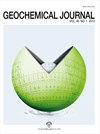Isotopic analysis of nickel, copper, and zinc in various freshwater samples for source identification
IF 1.6
4区 地球科学
Q3 GEOCHEMISTRY & GEOPHYSICS
引用次数: 7
Abstract
Nickel (Ni), copper (Cu), and zinc (Zn) are commonly used in human activities and pollute aquatic environments including rivers and oceans. Recently, Ni, Cu, and Zn isotope ratios have been measured to identify their sources and cycles in environments. We precisely determined the Ni, Cu, and Zn isotope ratios in rain, snow, and rime collected from Uji City and Mt. Kajigamori in Japan, and investigated the potential of isotopic ratios as tracers of anthropogenic materials. The isotope and elemental ratios suggested that road dust is the main source of Cu in most rain, snow, and rime samples and that some of the Cu may originate from fossil fuel combustion. Zinc in the rain, snow, and rime samples may be partially attributed to Zn in road dust. Zinc isotope ratios in the Uji rain samples are lower than those in the road dust, which would be emitted via high temperature processes. Nickel isotope ratios are correlated with V/Ni ratios in the rain, snow, and rime samples, suggesting that their main source is heavy oil combustion. Furthermore, we analyzed water samples from the Uji and Tawara Rivers and the Kakita River spring in Japan. Nickel and Cu isotope ratios in the river water samples were significantly heavier than those in rain, snow, and rime samples, while Zn isotope ratios were similar. This is attributed to isotopic fractionation of Cu and Ni between particulate-dissolved phases in river water or soil.不同淡水样品中镍、铜和锌的同位素分析,用于来源鉴定
镍(Ni)、铜(Cu)和锌(Zn)是人类活动中常用的物质,对河流和海洋等水生环境造成污染。最近,Ni, Cu和Zn同位素比值被测量以确定它们在环境中的来源和循环。我们精确测定了日本宇治市和鹿城森山雨、雪和白垩的Ni、Cu和Zn同位素比值,并探讨了同位素比值作为人类活动物质示踪剂的潜力。同位素和元素比值表明,在大多数雨、雪和霜样品中,道路粉尘是铜的主要来源,部分铜可能来自化石燃料燃烧。雨、雪和白霜样品中的锌可能部分归因于道路粉尘中的锌。宇治雨样品中的锌同位素比率低于道路尘埃中的锌同位素比率,道路尘埃将通过高温过程排放。镍同位素比值与雨、雪和雾凇样品中的V/Ni比值相关,表明其主要来源是重油燃烧。此外,我们还分析了日本宇治河和田原河以及Kakita河泉水的水样。河流水样中镍、铜同位素比值显著高于雨、雪、水样,锌同位素比值相近。这是由于Cu和Ni在河流水或土壤中颗粒溶解相之间的同位素分馏。
本文章由计算机程序翻译,如有差异,请以英文原文为准。
求助全文
约1分钟内获得全文
求助全文
来源期刊

Geochemical Journal
地学-地球化学与地球物理
CiteScore
1.70
自引率
12.50%
发文量
11
审稿时长
6 months
期刊介绍:
Geochemical Journal is an international journal devoted to original research papers in geochemistry and cosmochemistry. It is the primary journal of the Geochemical Society of Japan. Areas of research are as follows:
Cosmochemistry; Mineral and Rock Chemistry; Volcanology and Hydrothermal Chemistry; Isotope Geochemistry and Geochronology; Atmospheric Chemistry; Hydro- and Marine Chemistry; Organic Geochemistry; Environmental Chemistry.
 求助内容:
求助内容: 应助结果提醒方式:
应助结果提醒方式:


